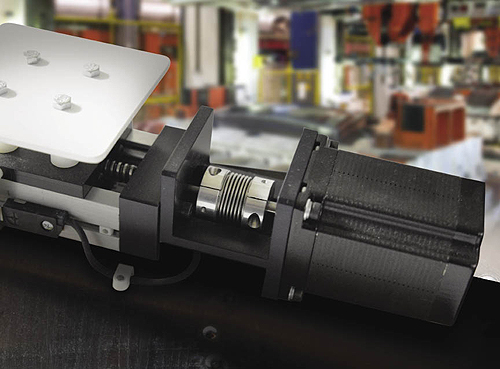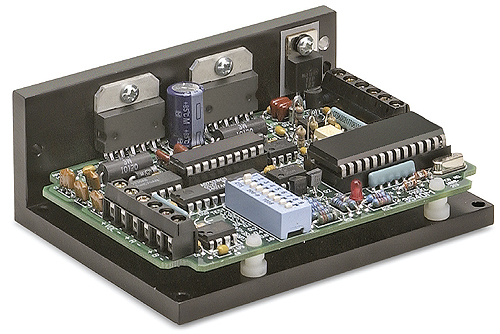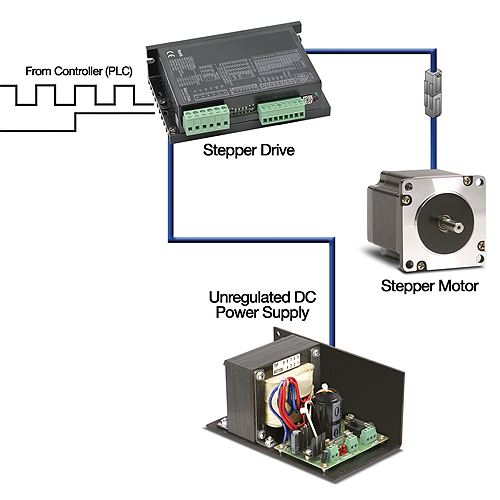By Joe Kimbrell, Product Manager for Motors and Drives, AutomationDirect
When deciding whether to build or buy, OEMs need to consider a myriad of factors including required design efforts, up-front costs and ongoing support.
Stepper motors are popular due to their low cost, especially in low power motor applications. Used in a range of industrial environments, they are rugged and reliable products that provide simple and accurate position and speed control. Easier to commission and less expensive than servomotors, they do not require encoders when used within their design limits.

To work properly, the stepper motor must be paired with a controller or indexer. The controller accurately regulates the speed and distance the stepper motor rotates by issuing pulse commands through a driver. It can be connected to a host main controller, such as a PLC, or it can operate as a standalone component. Some advanced stepper motor controllers include additional I/O and processing capability, allowing them to act as the main controller in a simple system.
The relative simplicity of stepper motor controllers has led some machine and robot builder OEMs to design and build their controllers in house. This can be the best approach if the OEM only needs simple controllers in large quantities, and maintains a relatively large in-house engineering staff for design and support of the controllers. However, this approach can easily end up being more expensive than planned as hidden costs add up.
Off-the-shelf stepper controllers used to be very expensive at a per-unit cost as compared to in-house designs, leading many OEMs to develop their own, but prices have declined significantly in recent years. As a result, many OEMs have been rethinking their development choices and reevaluating the merits of building versus buying stepper motor controllers.
Here are several instances in which purchasing an off-the-shelf stepper motor controller may be ultimately more cost effective, and why the in-house option can be problematic.
Build or buy?
Constructing a stepper motor controller can seem fairly easy, but its simplicity can also be deceptive. A basic stepper motor controller chip can cost as low as five or six dollars, but the time designing the board that hosts the chip and its associated components must also be considered.
Numerous websites exist describing how to build stepper motor controllers, and these sites can be helpful for simple systems. But many controllers must perform sophisticated command functions that necessitate complicated algorithms, and these situations require an intimate understanding of the motor and the task to be executed, information that can’t be gleaned from simply perusing a web site.
A stepper motor controller generates a pulse train that drives the motor, including variations of frequency for accelerating and slowing down the motor. It typically includes software algorithms that are executed to perform the calculations that generate the exact values of pulses and frequencies needed to move the motor to a certain position at the desired speed.
While many OEMs have competent engineering staff to handle the sophisticated stepper motor controller designs, especially if they’ve done similar designs in the past, they may overlook some of the complexities inherent to in-house designs.

In-house design challenges
If only the up-front purchase price of the raw components that make up the stepper motor controller are considered, it will always be cheaper to build rather than buy. But there are many other costs that must be considered, and adding up all these costs often tilts the scales in favor of buying rather than building.
First among these costs is the time required to design, assemble and test the controller. Procurement costs can also be a significant factor, as a stepper motor controller is made up of scores of parts, from major components like the controller chip to inexpensive but nonetheless critical items such as connectors.
Another cost is designing software drivers to communicate from the stepper motor controller to the main controller. If the main controller is a PLC, then the OEM’s customer will often specify the PLC brand, which can require a new driver.
Another often overlooked aspect involved with creating stepper motor controllers in-house is the need to keep track of changes made by the component parts’ manufacturers. Every time a manufacturer changes a part number, the OEM must spend time searching catalogs to try to find an equivalent. Multiply this expense by the number of manufacturers used to source parts, and the labor costs quickly escalate.
Support is another area that raises concerns. OEMs designing their own controllers must be certain the parts suppliers will be in business for the life of the machine. They may also encounter suppliers that design new replacement parts over the years. In this scenario, the OEM may need to re-adapt its designs if the new part characteristics are slightly different.
Problems also occur when the new parts require rewiring as opposed to a drop-in replacement. What initially was an easy assembly process has now become more complex, and maintenance and repair costs rise accordingly.

The expert trap
Designing all their own system components can cause OEMs inadvertently to fall into the “expert trap,” which simply means that the OEM becomes heavily dependent on their internal experts and their often unique expertise with in-house designs.
After a few years, however, OEMs can find themselves spending increasing amounts of time supporting their self-created designs, particularly if one or more of these experts is no longer with the company. Internal staff can then find themselves spending long hours supporting systems that have long been bought and paid for, instead of focusing on new systems and customers. Some may even find that the majority of their operations need to be focused on maintaining existing equipment.
These OEMs’ proprietary designs usually adhere to engineering that was done years ago. This becomes problematic when they lose engineering talent and expertise. In addition to the natural turnover from workers changing companies, today’s OEMs are facing large numbers of mature engineers retiring. Thus, they must replace experienced workers with younger workers who will be unfamiliar with proprietary products, and even with the hardware and software components used to design these products.
OEMs that intentionally or unintentionally build a model that apportions a large percentage of their business to customer support will have to contend with competitors using different strategies, ones that focus more on new sales than existing systems. In addition, some OEM customers may be uncomfortable with such a model for a variety of reasons.
Market acceptance
Building items in-house gives an OEM an intimate knowledge of every part of their system, and results in proprietary designs that can’t easily be copied by competitors. Using in-house designs also creates a business model that keeps an OEM’s customers returning to them for support that can create a revenue stream; albeit one that requires significant internal engineering and other technical staff.
But some if not most of an OEM’s customers may reject this model, preferring to instead support their machines and robots in house. For these customers, OEMs need to buy rather than build so that their customers can perform their own routine maintenance and repair.
When deciding whether to develop or buy a stepper motor controller, OEMs must consider these market trends. Simply put, many customers are now demanding that their OEMs use common off-the-shelf components to simplify their own internal support efforts, and to lessen their dependence on their OEMs.
Many of these OEMs customers have competent employees who can perform basic maintenance and troubleshooting on standard purchased components, but not on proprietary designs. When they open the cabinet they expect to see that each component has a label and a part number, so if they need a replacement they can simply call the vendor, or source the part from multiple distributors for the best price.
If the component is of a proprietary design, the customer must call the OEM, and he or she often needs to speak with the expert who designed the component in order to ascertain correct ordering and installation information.
By contrast, a customer using a system from an OEM built with off-the-shelf components, such as stepper motor controllers, can simply call the vendor or a local distributor and procure the part quickly, and can also receive support assistance as required.
Even the largest OEMs won’t have parts stocking, sophisticated shipping and support systems to match those provided by component vendors—and thus can’t provide the service demanded by many of their customers.
Buying is better for advanced applications
Designing and building a basic, standalone stepper motor controller is rather simple, but that’s not the case with the more sophisticated designs required to meet more demanding applications. In these situations, buying is almost always the preferred option over building in-house.
Stepper motor controller manufacturers have spent years developing controllers with advanced features such as special current limiting algorithms, fractional step abilities, resonance reducing capabilities and many more features that go beyond the basics.
While an OEM may not need all the functions of an off-the-shelf controller for every system, purchasing such a component can allow for standardization across an OEM’s entire product line.
There are many factors in determining whether to purchase an off-the-shelf controller or design one in-house. Smaller OEMs in particular need to balance the cost of development time and maintenance commitments inherent to internal designs against what may be higher initial costs for a purchased controller.
Larger OEMs will often see initial cost reductions from designing their own stepper motor controllers, yet may fail to consider customer preferences or the time required by their own workers to source parts and support existing systems. These OEMs must also consider the required ongoing investment in their engineering staffs that will be required to support proprietary designs.
With more affordable, advanced stepper motor controllers on the market, OEMs may want to reconsider the belief that using their own designs equal cost savings. Even those OEMs that make these calculations and determine it remains more cost effective to create their own controllers can shorten development time by purchasing manufactured units for prototype testing.
There’s no one solution for all users, as each OEM must makes its own choice to build or buy. However, the market now provides many affordable choices in stepper motor controllers that can help OEMs improve their business in a variety of ways as listed in the accompanying list and throughout this article.
Benefits of Buying Rather than Building Stepper Motor Controllers
1. More affordable price points than in past
2. Provides advanced features and functions
3. Eliminates parts sourcing and tracking
4. Allows OEMs to focus on new sales, not support
5. Easy to install and replace
6. Enables end users to maintain their own systems
7. Helps reduce development time
8. Satisfies market demand for off-the-shelf components
AutomationDirect
www.automationdirect.com


Leave a Reply
You must be logged in to post a comment.